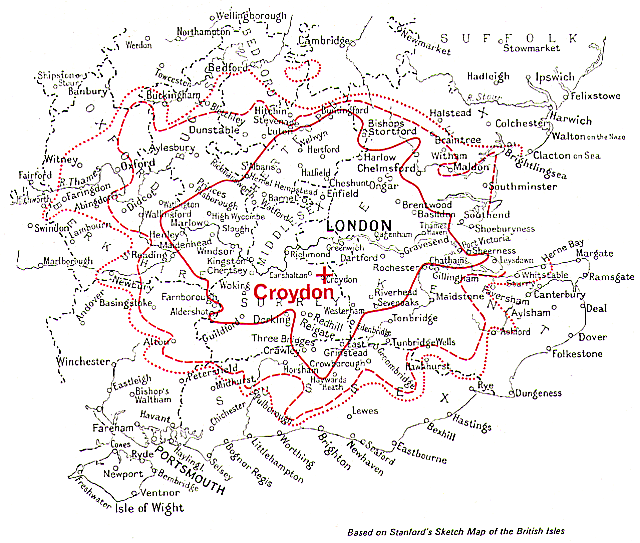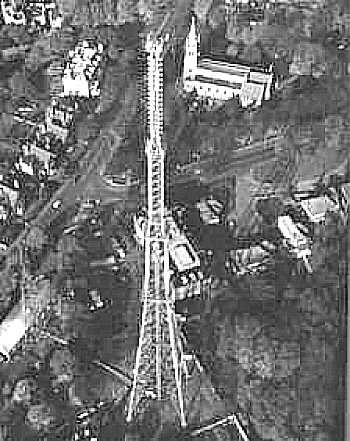 |
UK Broadcast Transmission |
|
|||||||||||
ITV 405 line VHF TV TRANSMITTERS
LONDON
| CROYDON | |||
| Channel / Polarisation | 9 V | ||
| Max. Vision ERP | 350 kW | ||
| Site ASL | 375 ft | ||
| Aerial ASL | 830 ft | ||
| Location (NGR) | TQ 332696 |

The authority's station on South Norwood Hill near Croydon served 13.5 million people in the London area, nearly a quarter of the total population of the United Kingdom. The London area is relatively flat except for the North Downs some twenty-five miles to the south and the ridge of the Chiltern Hills some thirty miles to the west and north. Topographically it presented no serious transmission problems; indeed, the difficulty was to find high ground close enough to the centre of London on which to construct a station. The choice lay between the 400 ft ridges of Muswell Hill (Alexandra Palace) in North London and Crystal Palace in South-East London. In 1935 the BBC had chosen Alexandra Palace as the site for its original London television station, but twenty years later they moved to a new station at Crystal Palace. In the interests of good planning the Authority decided to locate its first station near this site. A suitable open space for the construction of a small compact station which could be brought into operation with the least delay was found just a mile away on South Norwood Hill. The single 10 kW transmitter, the first Band III set constructed in this country, was a laboratory prototype. The aerial was an experimental 8-stack omnidirectional vertically polarised array supported on a 200 ft tower of virtually 'stock' design. The first Independent Television programmes were transmitted from this station on 22nd September 1955. With an effective radiated power (e.r.p.) of 60 kW (peak white vision) and 15 kW (carrier sound) the potential population coverage was about 11 million. After some months a second fully-engineered production 10 kW transmitter was installed as a standby, and a little later further equipment was installed to enable both sets of transmitters to be operated in parallel in order to double the station's power. In due course the Croydon station would be given a higher tower and a new aerial system with directional characteristics tailored to give the optimum performance. Meanwhile engineering effort was devoted to expanding the ITA network of stations to meet the fast-growing public demand for Independent Television programmes in other parts of the country. The completion of the BBC's high tower at Crystal Palace allayed any fears that the mutual reflection of signals radiated from the two towers just a mile apart might be harmful to reception, and in February 1959 the ITA obtained Government approval to erect a higher tower and directional aerial at the Croydon site. By the 5 December 1962 Croydon was transmitting from its slim new 500 ft tower and radiating an effective power of about 350 kW directed to the north-west, with 50 to 250 kW e.r.p. in other directions, the strength of signal being determined by the requirements of topography and the avoidance of co-channel interference with other ITA stations and television services of other countries. The improved performance of the Croydon station in 1962 extended the ITA's London area coverage to include a population of 13.1 million. The transmitters were replaced in 1969, which turned out to be the only ITA site where this happened. |
 |
|